Small-ScaleDairy Farming Manual |
Volume 4 |
|
|
|
IN DAIRY BUFFALO AND CATTLE |
 |
|
Husbandry Unit 1.1: Technical Notes Note:Numbers in brackets refer to illustrations in the Extension Materials. |
|
|
 |
What is A.I. and why use it? (5-20) 1 A.I.:
|
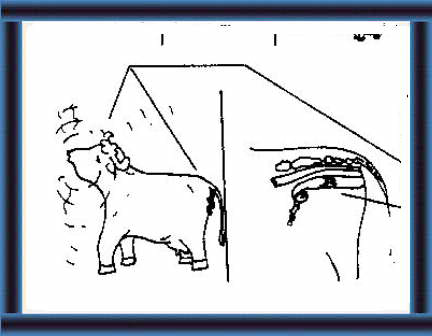 |
How does your cow show heat and how do the
female reproductive organs work? (21-46)
2 You should know:
|
 |
How does the A.I. technician inseminate your
cow? (47-56)
3 He prepares the semen and uses a breeding gun to inseminate your cow. |
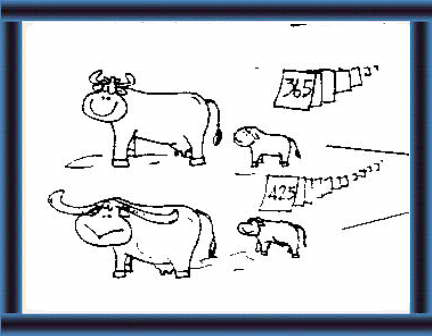 |
How often should your dairy cow calve and
are there any differences for buffalo? (57-69)
4 Dairy cattle should calve every 365 days. Buffalo should calve every 425 days.
|
|
A.I. stands for "Artificial Insemination". A.I. is different from natural mating. In A.I. semen is collected artificially and deposited in the uterus of the cow. A.I. is widespread and used in many countries, especially for breeding dairy cattle. |
 |
5 In natural mating a bull mounts a cow and ejaculates his semen into her vagina. |
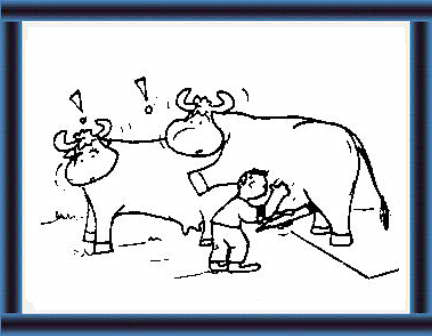 |
6 In artificial insemination (A.I.) the A.I. technician collects semen from a bull in a bag called an artificial vagina. |
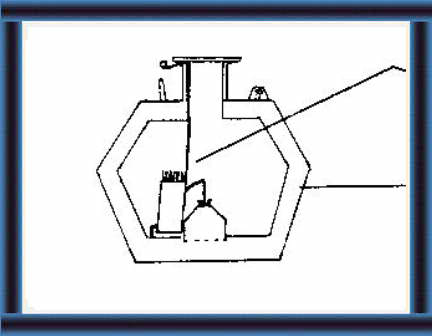 |
7 He keeps the semen frozen in a special container until you need it for your cow. |
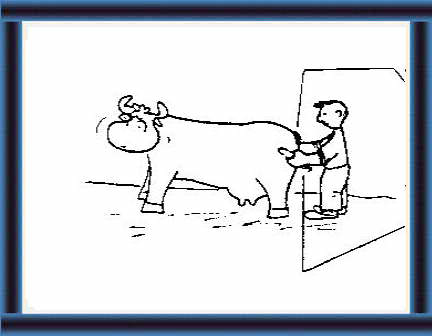 |
8 When the cow is in heat, the A.I. technician
inseminates
the cow with a breeding gun (insemination rod).
|
|
Important reasons for using A.I. are: - No direct contact between bull and cow. This reduces the risk of transfer of disease and of injuries from natural mating. (9) - One portion of semen (ejaculate) from one bull can be divided into enough doses to inseminate 200-250 cows. In natural mating, one bull can serve only about 30 cows per year. A.I. transfers the genes from a good bull to a large number of offspring and breed improvement takes place much more quickly than in natural mating. (10-12) |
page 6
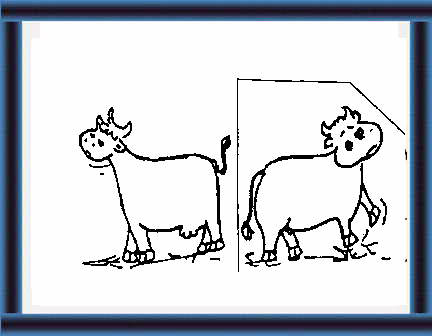 |
9 Artificial insemination of
dairy buffalo and cattle has many advantages:
No direct contact between bull and cow. This means:
|
 |
10 Semen from one bull
can be used for inseminating many cows.
This means:
|
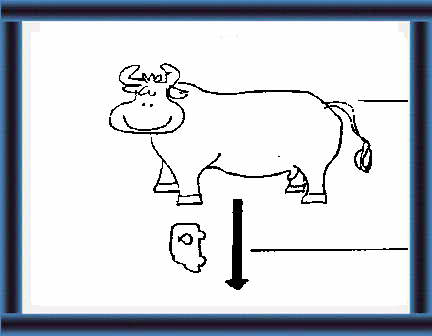 |
11 You can take semen from a bull in one place |
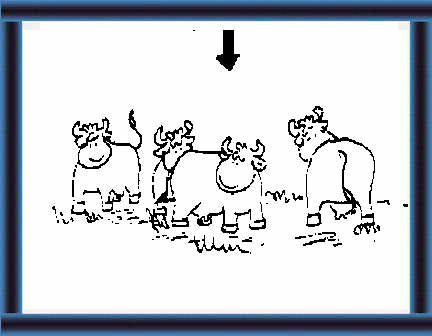 |
12 and transport it to cows
in
other
places.
|
| 3. A.I. technicians
use semen from different bulls even in small herds. This allows the
farmer to choose his own breeding policy. (13)
4. Depending on local conditions, A.I. costs may be lower than the costs of keeping a herd bull. (14-15) |
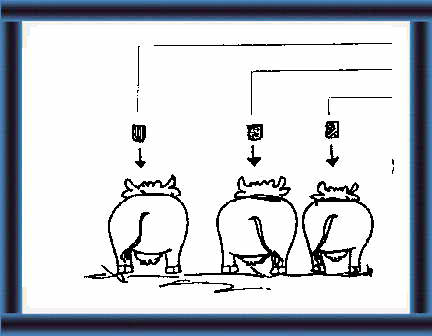 |
13 Even in small herds, you can use semen
from different bulls.
This means:
|
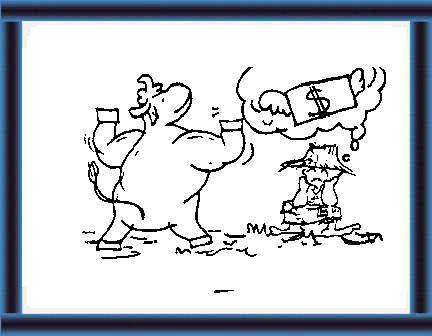 |
Remember: |
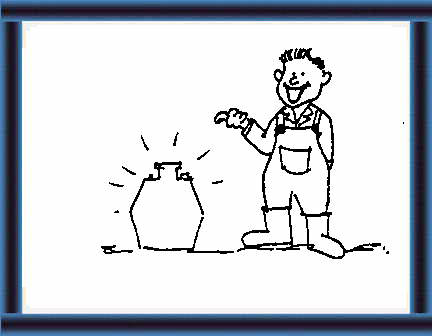 |
Artificial insemination
15 A.I. may be cheaper than keeping a herd bull. |
| The use of A.I. for riverine
(e.g. Nili-Ravi) and swamp buffalo is limited for two main reasons:
1. A.I. is not available. 2. Faulty techniques for A.I. |
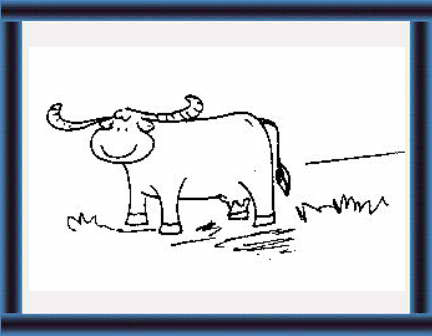 |
16 As well as dairy cattle,
A.I.
is suitable for both Swamp buffalo
|
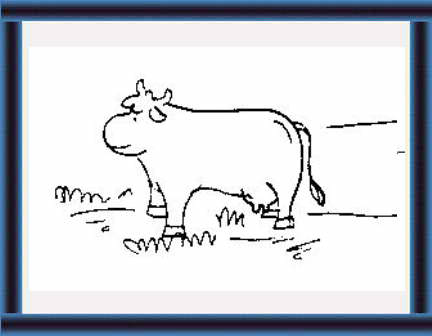 |
17 and River buffalo.
If you have difficulty:
|
|
- The A.I. system will only work well if the management of the farms is efficient, in particular the farmers' ability to perform heat observation. (18) - The regular use of A.I. in a certain area requires a well organized A.I. system with continuous recording and monitoring and well trained A.I. personnel (inseminators). - Semen may transfer undesired heritable traits and infectious diseases. The A.I. technician must use only checked semen taken from a bull which has been tested not to transfer undesired traits and not to carry and diseases transferable by semen. (20) |
Things to remember in A.I.
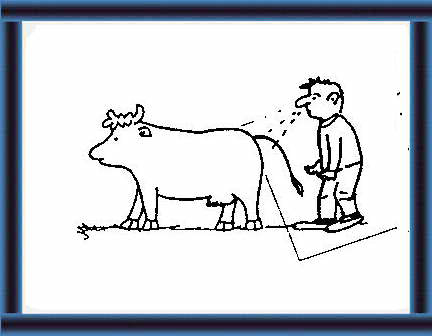 |
Make sure:
18 - you are able and ready to observe signs of heat in your cow
|
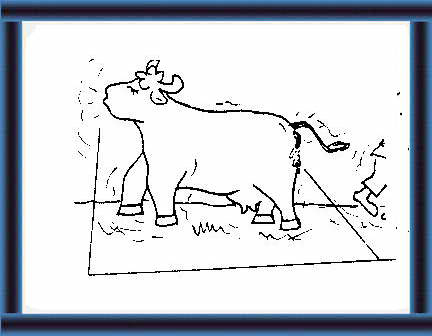 |
19
- you can call the A.I. technician quickly when your cow shows signs of heat |
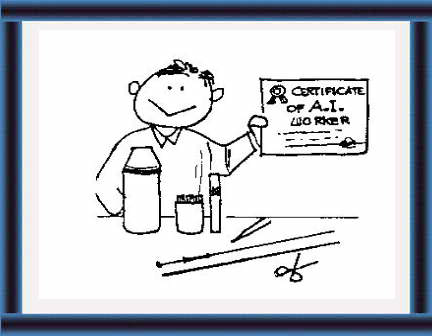 |
20
- you use an A.I. technician who is well trained. |
|
A non-pregnant cow with a normal oestrus cycle will release an egg and show heat about every 21 days (variation: 18-24 days). The typical signs of heat are: 1. Restlessness, the cow separates from other cows when it is walking in the field. (21) 2. Some breeds bellow to attract the bull. Zebu (=native) cattle, however, normally do not bellow. (22-23) 3. Milk production and food intake may decrease. (24) |
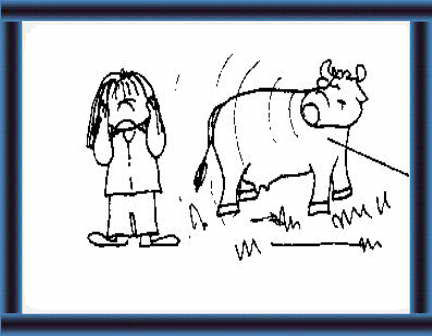 |
22 The cows of some breeds of dairy buffalo and cattle bellow to attract the bull. |
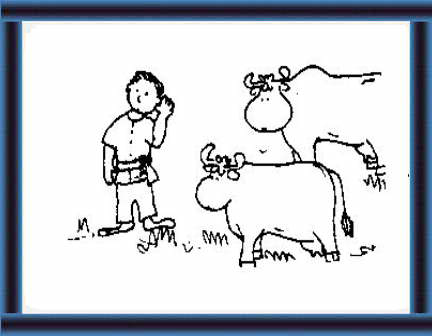 |
23 Some cows of certain breeds
of dairy cattle (e.g. Zebu) and dairy buffalo (e.g. Nili-Ravi) do not bellow.
They have silent heat. |
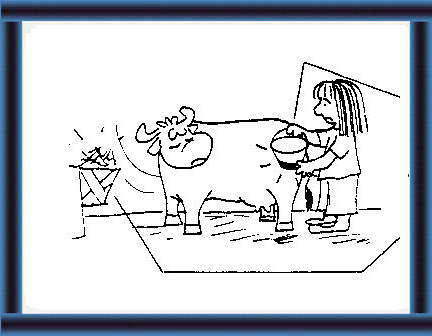 |
24 Food intake and milk production
may decrease.
|
| 4. The cow tries to mount other
animals, sniffs at others, and other cows sniff at the cow in heat.
(25-26)
5. Other cows try to mount the animal in heat and she stands and allows them to do so: standing heat. (25-26) 6. The lips of the vulva become red and swollen. (27) 7. A thin, clear discharge from the vulva opening can be seen, sometimes sticking to the tail and skin surroundings. (27) 8. By rectal palpation increased uterus tonus can be felt. Extra care in heat observation needs to be taken with buffalo cows. Many of them: (28-9) - Show very poor signs of heat and may have silent heat. - Come on heat late at night when the signs are more difficult to detect. |
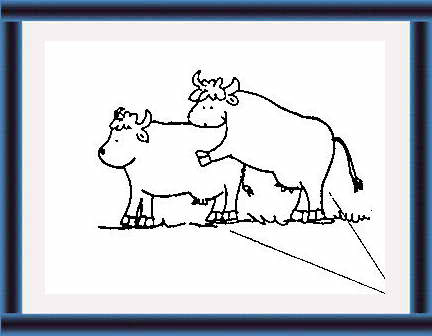 |
25 The cow in heat tries to
mount
other cows.
The cow in heat allows other cows to mount her. This is called standing heat and is important
to
notice.
|
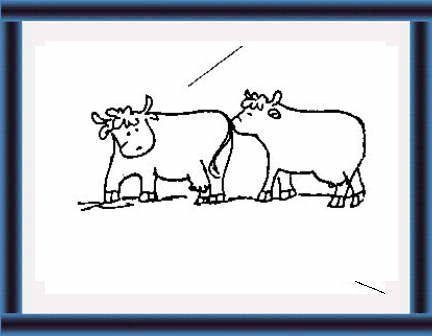 |
26 Other cows sniff the cow in heat. |
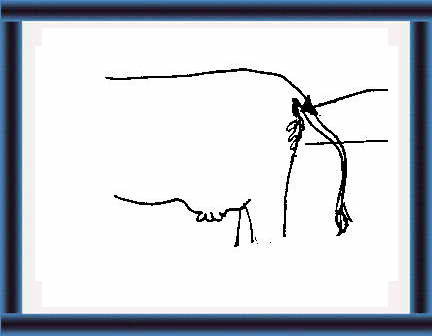 |
27 The lips of the vulva become
red
and swollen.
You may see a thin sticky clear discharge like egg white. This runs from the vulva and may stick to the tail and skin. |
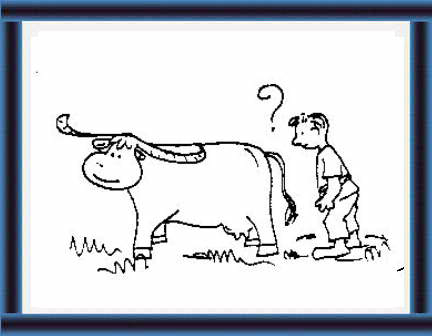 |
28 Buffalo cows often show poor
signs of heat and have silent heat.
You must observe carefully.
|
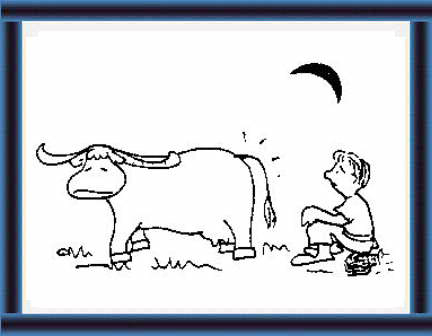 |
29 Buffalo often show signs of heat late at
night.
You should check them at this time. |
| Normally, the farmer will
not see all signs of heat at the same time. Some signs of heat may
be absent or too weak to be observed. (31)
The standing heat period normally lasts 18-20 hours, but may be several hours shorter or longer. (33) For the inseminator it is important not only to question the farmer about previous inseminations, treatments and proper heat signs but also to check by himself that the cow to be inseminated: 1. Really is in heat: insemination of cows not in heat easily causes infection of the uterus (metritis, pyometra). 2. Has no reproductive disease (especially uterus infection), in which case insemination is not likely to succeed. 3. Is not pregnant already: insemination
of pregnant cows results in abortion. Timing of insemination The best possibility for getting a cow pregnant is when insemination is done in the last half of the standing heat period or within 6-8 hours after the end of the standing heat period. (33-38) |
 |
30 The heat period is short.
Be ready to observe:
|
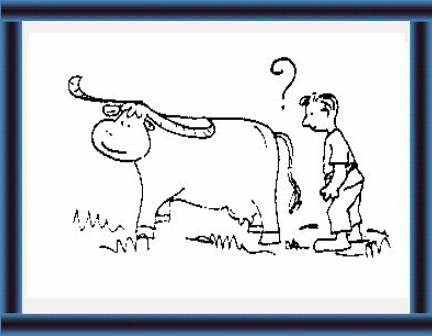 |
31 You may not see some heat signs at all. |
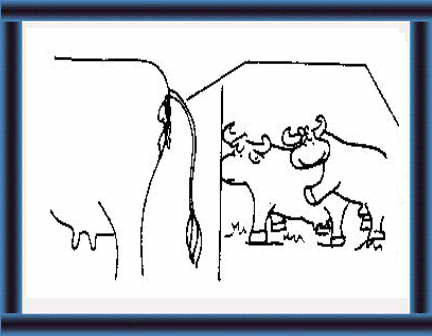 |
32 Look out for the typical discharge and
for standing heat.
Your cow is in heat. When do you inseminate? |
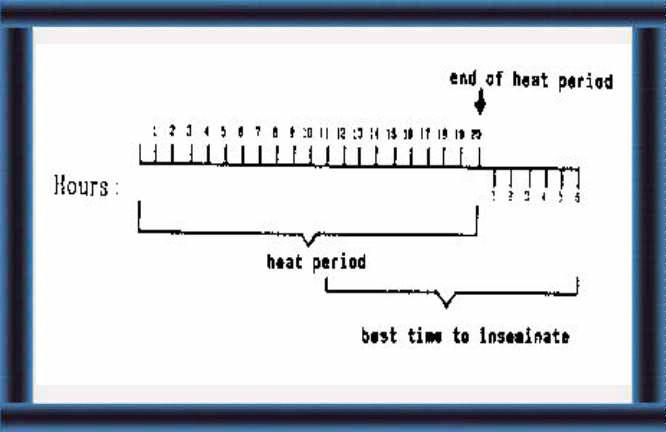 |
33 Inseminate the cow towards the end of
the heat period or at latest within 6 hours of the end of
the heat period.
|
| The normal working routine to
follow is:
1. If the farmer observes heat early in the morning, inseminate in the afternoon of the same day. (34) 2. If the farmer observes heat in the afternoon, inseminate early next morning. (35) |
 |
34 Heat signs
early
in
the morning.
Inseminate in the afternoon - same day.
|
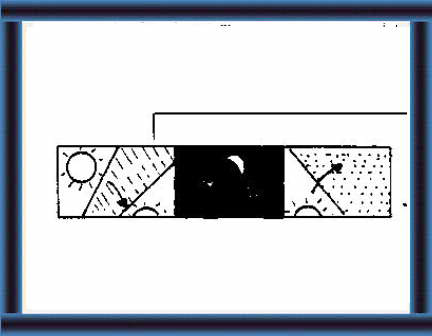 |
35 Heat signs in the afternoon.
Inseminate in the morning - next day. |
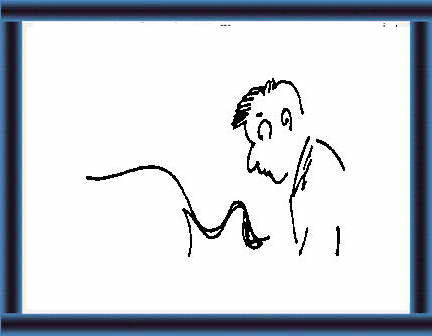 |
Remember:
36 Look carefully for signs of heat. |
 |
37 Inform the A.I. technician quickly,
within
3-5 hours of observing heat.
|
| Fertilization, that is the combining of egg and sperm, takes place when the egg reaches the egg duct. If the A.I. technician performs the insemination too early, the sperm deposited in the cow dies before the egg reaches the egg duct. If he performs the insemination too late, the egg dies before the sperm is deposited. Therefore, neither too early and too late inseminations will result in pregnancy. (38) |
38
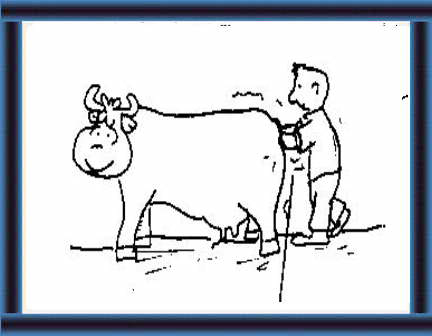
Inseminate at the right time: at end of the heat period: - your cow should get pregnant.
|
|
The illustrations below show the anatomy of the female reproductive organs of dairy buffalo and cattle. 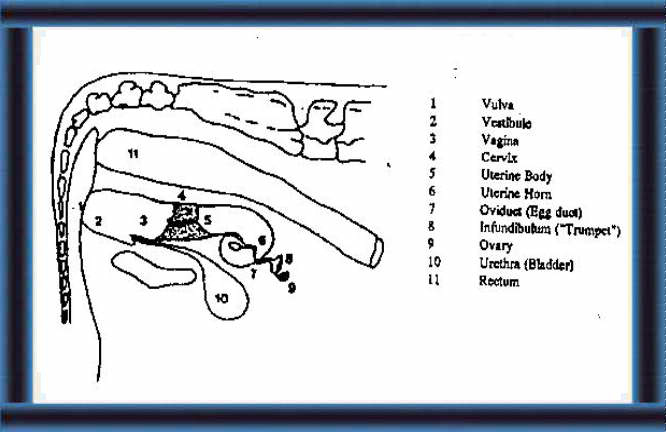
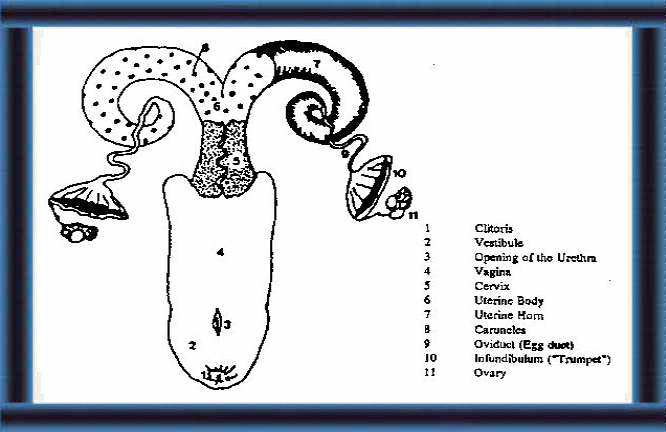 After release, the infundibulum or "trumpet" catches the egg and then it reaches the egg duct (oviduct). In mating or A.I., fertilization with a sperm cell takes place here. The fertilized egg moves to the uterus horn where it attaches to the wall and develops into a fetus. Correct A.I. technique deposits the semen in the uterine body, not in one of the horns. |
|
Introduce the breeding gun (insemination rod) into the vagina. The plastic sheet over the breeding gun is sterile. Keep it as clean as possible during the insemination procedure. One way to do this is as follows: introduce the left arm into the rectum and exert a moderate pressure downwards to open the vulva. When the mucosa becomes visible, introduce the breeding gun without touching the skin. (52-53) Introduce the breeding gun further along the upper wall of the vagina to avoid introduction into the blind saccule in front of the urethra or into the urinary bladder. At this stage, check for possible non-heat, abnormal conditions or pregnancy by rectal palpation with the left hand. If insemination is continued, press the vaginal part of the cervix forwards with forefinger, thumb and middle finger. Introduce the breeding gun to contact the fingers at the same time. 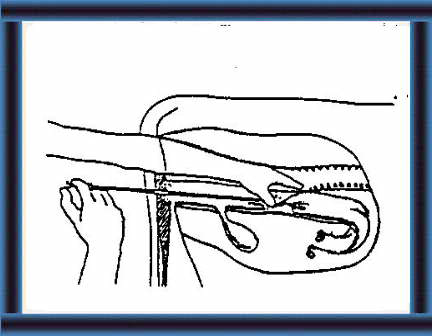
Breeding gun in position in front of the cervix |
 |
Preparing the semen
44 The A.I. technician freezes the semen and keeps it in straws in the special container. |
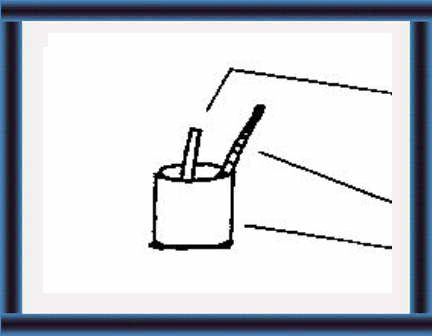 |
45 He removes a straw and thaws it in water immediately before use. |
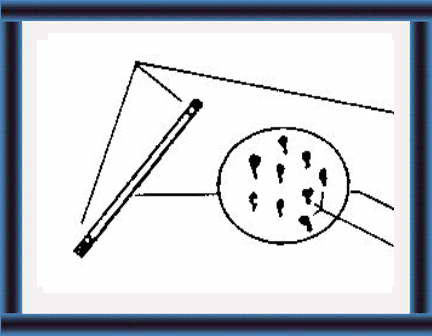 |
46 The straw is
sealed
at
both ends.
One straw contains 20 - 30 million sperms. |
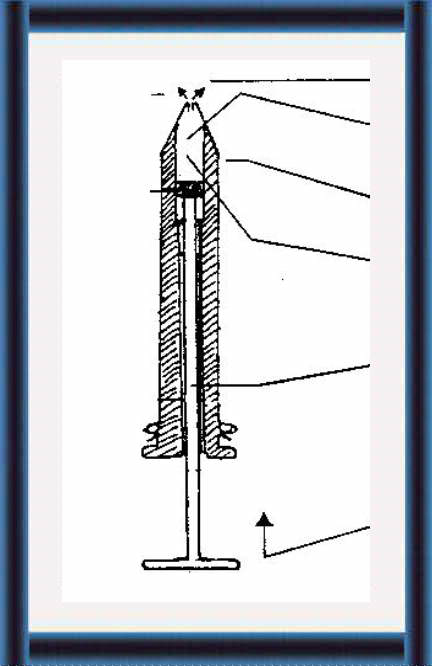 |
47 He places the
straw inside
the breeding gun.
semen inside the straw piston
The semen comes out
when he pushes the piston.
|
|
5. When the tip of the breeding gun is in position outside the cervix opening, gently try to push the breeding gun through the cervix, without using force.  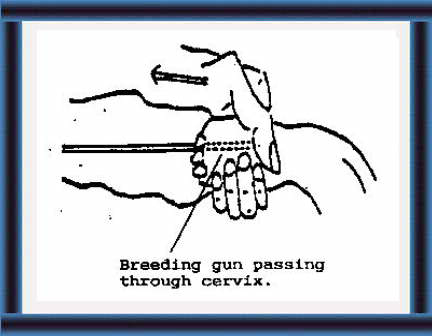
Breeding
gun in position
Breeding gun passing
6. With the tip of the forefinger you can feel when the tip of the breeding gun passes through the cervix into the uterus body. This is the correct place of deposit. 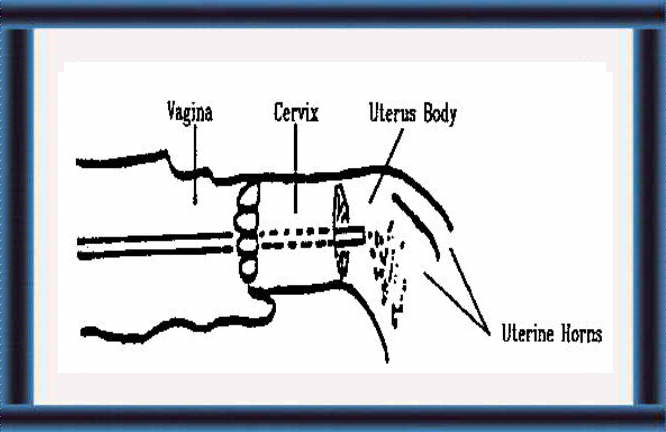 Important things to remember: 1. Always work as cleanly as possible. If you introduce any dirt into the uterus, it may cause infection, especially if the cow is not in heat. 2. Always check the cow for abnormal conditions such as abnormal discharge, different size of the two uterine horns, possible pregnancy or missing heat. If in doubt about insemination, wait and check later or ask a veterinarian to check. 3. Follow a sensible routine when you inseminate. This makes the work quicker and ensures that you always use a hygienic procedure. |
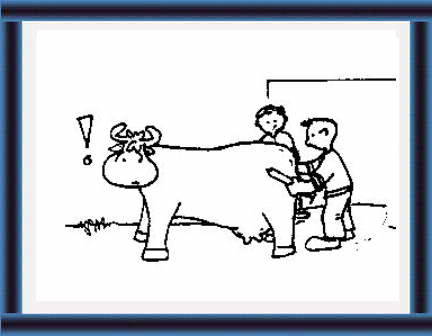 |
48 The farmer should stand beside
the
cow.
This keeps the cow calm. The A.I. technician stands behind. |
 |
49 The A.I. technician puts
one
arm into the gut (rectum) of the cow.
He fixes the neck of the uterus through the wall of the gut. |
|
Sometimes the farmer does not know that his cow is pregnant and asks for insemination of a pregnant animal. Some cows may also show signs of heat even though they are pregnant already. At the examination before A.I., it is possible for the inseminator to diagnose a possible pregnancy from day 60 after conception. A number of conditions indicate pregnancy, the most significant are as follows: - Different size of the uterine horns. This may be due to pregnancy, but may also come from inflammation or previous calving. - Fluid content in one or both horns (may also be due to inflammation). - Slip of fetal membranes when the inseminator lifts up the uterus wall. - Palpation of placentomes, the size is about 1-2 cm diameter at 3 months pregnancy up to about 8 cm at 8 months pregnancy. - From about 70 days after conception the inseminator can feel (part of) the fetus. Beware that the fetus may be out of reach at about 5-6 months pregnancy where it "drops" down on the abdominal wall. - From about 90 days after conception, the inseminator can feel the increased size and pulsation of the middle uterine artery at the pelvic wall. The size of the artery is about 4-5 mm diameter in early pregnancy, becoming increasingly larger later in pregnancy. If there is any doubt that the cow is pregnant, do not inseminate but wait and examine at a later stage. |
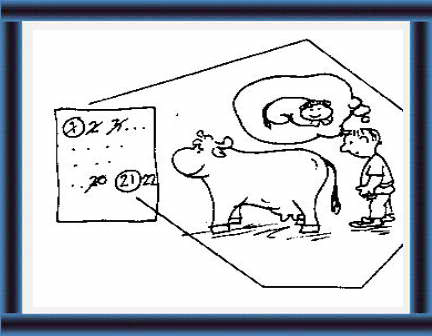 |
51
After A.I. observe carefully for signs of heat.
No signs of heat 21 days after A.I. means that your cow may be pregnant. |
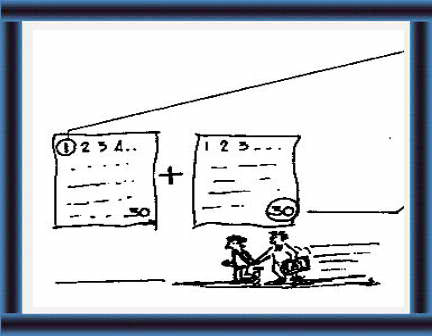 |
52 60 days after A.I., if there are no signs of heat, call the A.I. technician or veterinarian to check for pregnancy. |
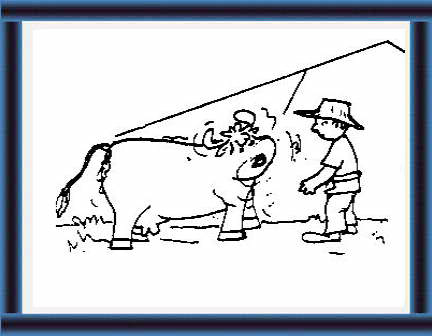 |
53 If there are signs of heat and the cow is not pregnant, repeat A.I. |
|
Repeat breeding Some cows fail to come on heat, show signs of heat irregularly or do not become pregnant after insemination (repeat breeders). The reasons for this may be many and can depend on the cow (abnormal body function) as well as the management (for instance: wrong feeding, failure of the farmer to observe heat). After 3 inseminations not resulting in pregnancy, ask the veterinarian to investigate causes of infertility. Infectious diseases Abnormal vulva discharge, repeat breeding, abortion, retained placenta, dystocia and still born or abnormal calves may all be signs of infectious disease. Other animals can get these diseases. If any of the above signs are present, isolate the sick cow from the rest of the herd and call the veterinarian at once. Man can catch some reproductive diseases (for instance: Brucellosis) and become seriously ill. Metritis Metritis is infection of the uterus and not uncommon after calving, especially with dystocia or retained placenta. Metritis may also be present after A.I. or mating. There is sometimes, but not always vaginal discharge. Other signs include reduced food intake, fever, general bad condition. The veterinarian can treat metritis and early treatment helps full recovery. |
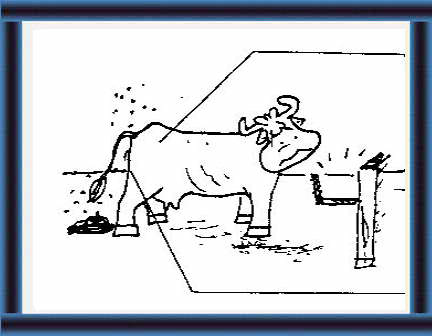 |
58 You may be doing something
wrong.
Check: - reproductive disorders - feeding and management - heat observation. |
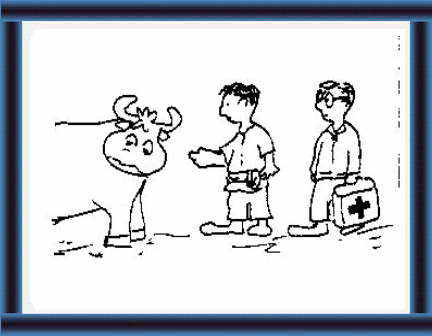 |
59 There may be something wrong
with
your animal.
Inform the veterinarian if your cow is not pregnant after 3 inseminations. |
|
In India, it has been observed that the manifestation of heat in buffaloes is weak and the heat is of shorter duration during summer. This necessitates close observation for different signs of heat at shorter intervals. It has further been observed that teaser bulls had poor libido during summer. For efficient heat detection, therefore, protection against climatic stress should be provided. It has been observed that few buffaloes exhibit signs of oestrus from 10 a.m. to 5 p.m. Most activity occurs near sun rise and sun set. Hence the breeding time is either missed during the night or breeding services at that hour are not available. Late sexual maturity (62-63) Puberty refers to the state of the animal when she is physically fit for reproduction as indicated by regular exhibition of the oestrus cycle. Sexual maturity has immense economic importance for successful buffalo dairy farming. Economically, early first calving will ensure smaller investment and quicker return of the capital. Genetically, it reduces the generation interval, resulting in larger annual genetic gain from selection. The skeletal parts grow more rapidly after birth than other tissues. This rapid rate of skeletal growth decreases by about six months. Maximum muscular development occurs thereafter. The maximum growth rate is between 3 and 6 months and falls steeply after one year of age. The young females when one year old are generally kept together with elder heifers and as such fail to get their share of nutrients. The problem appears to be one of management. On average, the age at first heat has been reported to be 30 months (range 26-62 months). It has been indicated that the occurrence of first heat is more a function of weight than age. Most buffaloes generally start exhibiting heat symptoms on attaining about 340 kg body weight. Hence breeding, feeding and management practices should be directed towards attaining this weight as early as possible. Buffaloes heifers fed normal rations but under intensive management alone could calve at 36 months of age. |
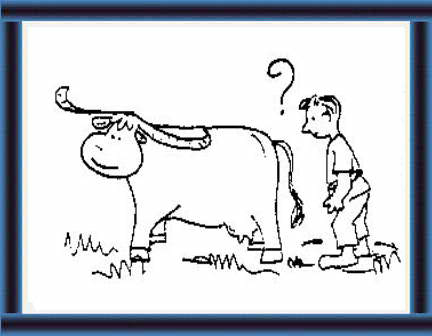 |
58 In buffalo, signs of heat:
- are often weak - are often short, especially during summer - often occur at night. You must observe carefully. |
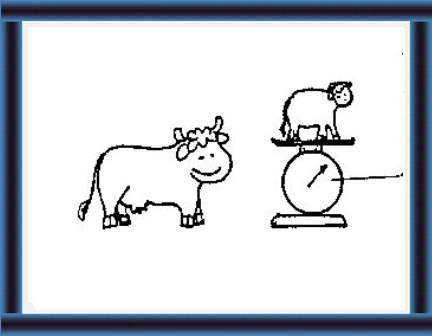 |
59 The first heat in buffalo depends more on weight than on age and usually occurs about 340 kg body weight. |
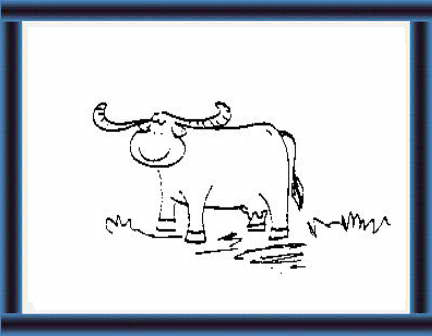 |
60 You should breed, feed and manage your buffaloes so they get to this weight as soon as possible. |
|
Breeding behaviour (64-66) Dairy farmers suffer economic losses due to low reproductive efficiency in seasons of high environmental temperature. Seasonality of calving in buffaloes has been much debated in the past. However, it is now quite well known that buffaloes breed and calve throughout the year but certain months and seasons are more favourable for breeding than others. Data regarding frequency distribution of oestruses and calving in Pakistan buffalo show that about 63 percent of the buffaloes came in oestrus during autumn (September to November) and winter (November to February). The distribution of calvings indicate that although the buffaloes calved throughout the year, the maximum calvings (39%) occurred during the humid - hot (July to September) season followed by 26% calvings during autumn (September to November). Spring calvers are very infrequent. From the analysis of data on Nili-Ravi buffaloes in Pakistan under farming conditions, it was revealed that when teaser bulls were allowed access to buffaloes throughout the year, the frequency of calvings improved. The sexual activity of the males, during May and June was minimum, the temperature was highest and buffalo often failed to come on heat. The animals started coming on heat from July to September (humid - hot season) and reached a peak during autumn when the day length was decreasing. In another study it was observed that of all calvings, 60 percent occurred from July to October. It was concluded that calvings in this period were followed by 40 days earlier return to oestrus, 48 fewer days open (service period) and 47 days shorter calving interval than for calvings in other months. |
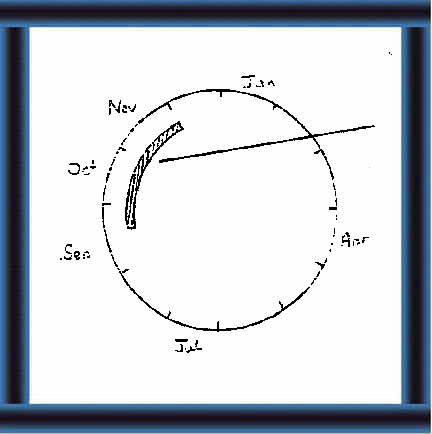 |
61 Buffaloes are very seasonal
animals.
Mid September to end November is the active breeding period. This is the best time for breeding.
|
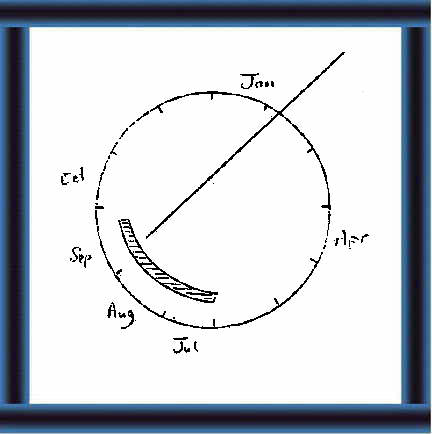 |
62 This shows the active calving
period.
The highest number of calvings is the period from July to September. |
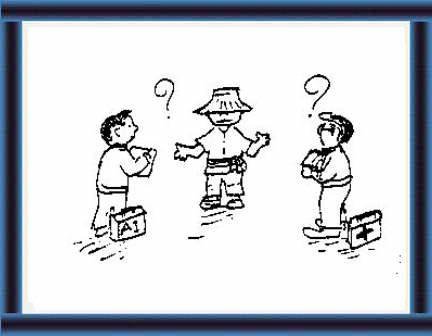 |
65 To keep your cow healthy and calving every year you need to record information to answer the questions of the A.I. technician and veterinarian. |
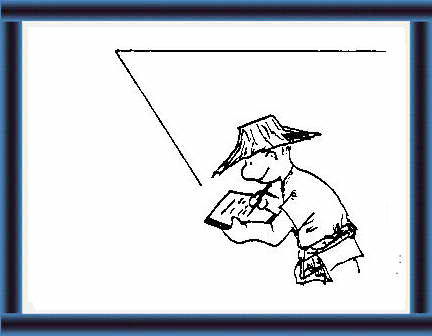 |
66 Keep records
on a
special card for each cow.
Write down important things about your cow. Then it is easy to remember. |
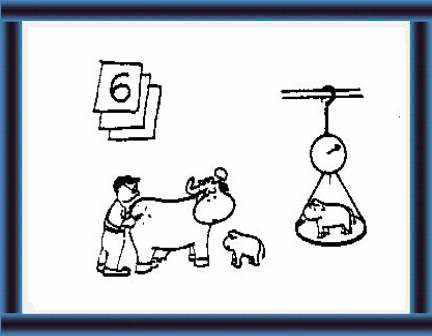 |
67 Keep records about:
- dates - what happened: calving, vaccination, A.I., health etc - the exact figures - anything special. Discuss the cow card with your A.I. technician or veterinarian. |
|
page 47